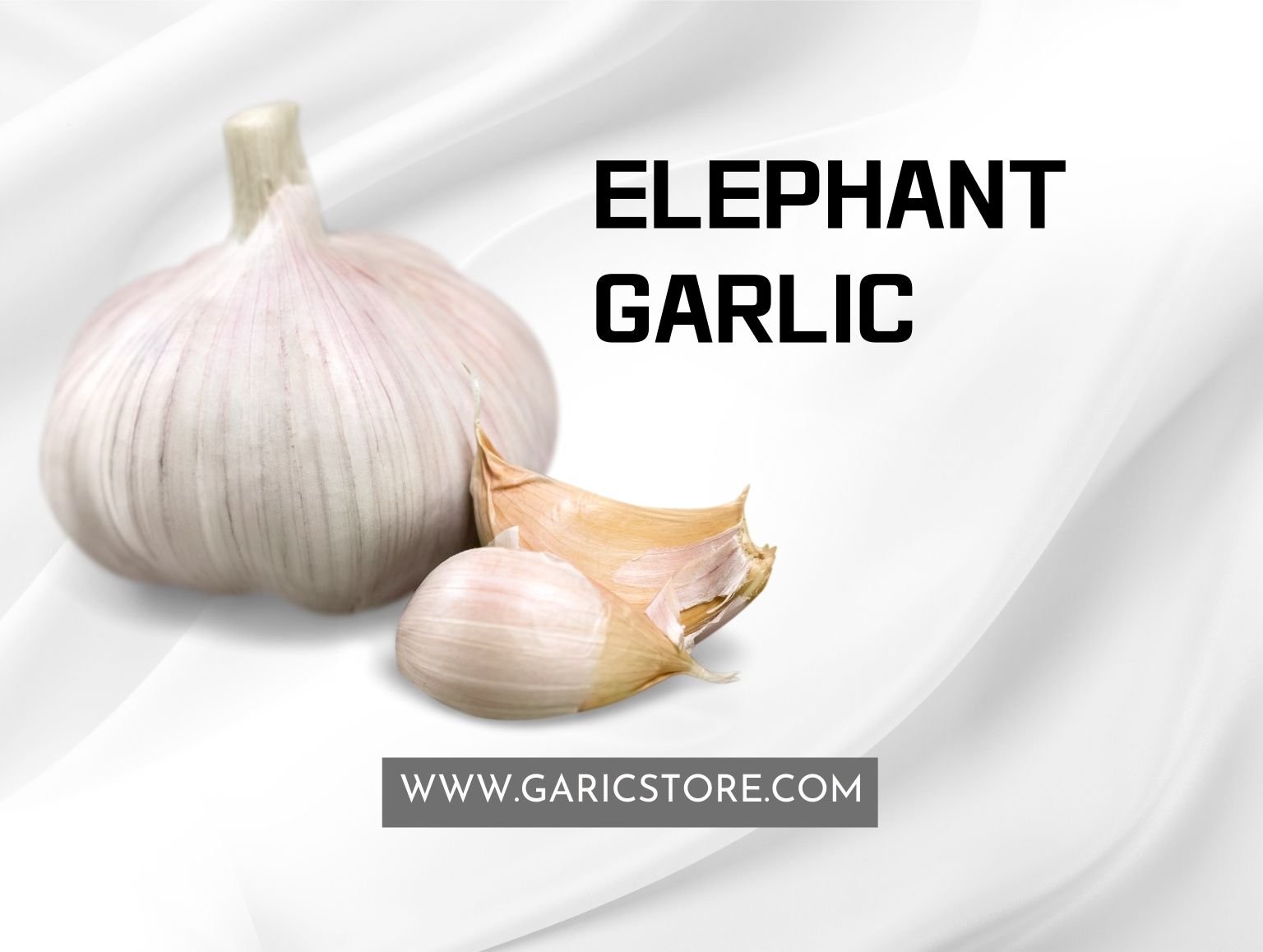Most gourmands use garlic on almost all dishes to enhance their flavor. If you are a food enthusiast but prefer a lighter flavor of garlic, consider using elephant garlic. Unlike other types of garlic, elephant garlic is a perennial plant, meaning it can remain in your garden for many years. It provides a great addition to perennial beds, polycultures, or wildlife gardens and can be grown in a wide range of different climates and conditions.
What is Elephant Garlic?
Elephant garlic, also known as Allium ampeloprasum (hard neck), is a giant perennial plant that belongs to the onion genus. Although a member of the allium family, elephant garlic is closely related to leeks. Like leeks, this plant has a tall, solid flowering stalk with broad, flat, blue-green leaves. However, it is garlic-like in flavor, and just like regular garlic, it yields bulbs made up of cloves.
Originally from Asia, elephant garlic yields large bulbs that weigh up to 1 lb. Each giant bulb contains 5 to 6 large cloves that are surrounded by smaller bulbet grows. Allium ampeloprasum attains a height of about 3 feet from bulb to the tip of the strap-like leaves. Its flavor is milder and mellower than regular garlic and much more palatable when eaten raw.
Uses
Each mature elephant bulb is broken up into individual cloves that are large with a papery covering. These cloves are used for:
Culinary Purposes
Elephant garlic has a sweet, mild flavor that is a favorite for many food enthusiasts. Plus, its cloves are huge, easy to peel, and can be eaten raw when sliced into salads. It can also be boiled or steamed as a vegetable, stir-fried like onions in a soup, roasted, or baked in the oven.
Ornamental Purposes
Elephant garlic can grow as tall as five feet, producing attractive flower heads. In addition, it produces beautiful pink flowers on top of the flowering head.
Pest Control
Elephant garlic can also be used at the back of gardens to repel pests like aphids and deer. The plants are strategically planted in gardens to discourage pests.
When is the Best Time to Plant Garlic?
This garlic variety prefers a long, cool growing season and is best planted in early fall. Planting in the fall gives your garlic more time to split into cloves. If you find it’s still one large bulb, you can leave it in the ground for another year to finish maturing. You can also opt to harvest the bulb.
The larger the planted cloves, the larger the bulbs it will produce. Harvest your fall-planted garlic about eight months later in late spring or early summer, which is approximately 240 days from planting. Elephant garlic planted in spring can be ready to harvest in 90 days. However, there is a high chance that spring-planted elephant garlic with yield a single clove.
Elephant Garlic Planting Requirements
Several factors affect the growth and harvest time of elephant garlic, including:
Climate
Elephant garlic needs cold weather to divide properly. As such, they do well in hardiness zone 3-9. It can grow in temperate regions into tropical zones. In cooler climates, plant your cloves in the fall or spring, while in warmer regions, you can plant the herb in fall, spring or winter.
Light
Like true garlic, Elephant garlic plants do well in full sun. This means that the plant should be exposed to direct sunlight for at least 6 hours on most days. That said, these plants can also grow in partial shade, but you will typically get larger bulbs if you grow them in full sun.
Soil
Elephant garlic plants prefer loose, organically rich soil with a neutral soil pH. As such, it is highly recommended to have your soil tested before planting. The results will give you insight into whether you need to make any pH or nutrient adjustments.
Fertilizer
Add organic matter through the growing season to keep the soil moist, protect roots from winter frost and restrict weed growth. If you have soil with high clay content, add large amounts of compost to your beds before planting. Light soils with loose textures require small amounts of organic matter or green manures like rye grass-clover.
Water
These plants need regular watering while they are actively growing. Water regularly so that the soil remains slightly moist but not soggy. Overwatering the soil can cause the bulbs to rot. We highly recommend watering in the morning so the foliage can dry before nighttime. Otherwise, damp foliage can lead to fungal growth. Loamy, well-drained soil is also key for growing these plants as they do not tolerate being waterlogged well.
How to Grow Elephant Garlic Bulbs
Elephant garlic plants make an attractive addition to any garden. Each tall stalk spikes up with a gorgeous flower that’s up to 1.5 m tall. To plant your elephant garlic, break up the bulbs into multiple separate cloves for propagation.
To grow the largest bulbs, you need to choose the biggest and healthiest cloves. Plant cloves with the pointed end upwards around 4-6 inches deep without removing the papery skin. Space the cloves about 8-12 inches apart to allow some airflow in between the plants.
You can also opt to plant the smaller cloves, which grow outside the bulb, called corms. When planted, corms produce a non-flowering plant in the first year with a single large clove. In the second year, the clove will begin to separate into multiple cloves.
Caring for Your Plants
Once planted, elephant garlic care is pretty simple. These plants do not need to be divided or harvested each year. Rather, they can be left alone, where they will spread into a clump of multiple bulbs. It is important to continue water regularly, especially if you are growing undercover and the plants are not exposed to natural rainfall. Just take care not to overwater your plants.
Your elephant garlic plants will send up flower stalks or scapes in a few weeks, just like regular hard neck garlic. However, these scapes consume the plant’s energy that should be going towards bulb growth. So cut the scapes back before they begin to bloom or curl. Fortunately, these scapes are not waste and can be used in the kitchen to make salads, pesto, or stir-fries.
Elephant garlic care also calls for the regular removal of any weeds that threaten to compete with your plants for space, water, and nutrients as they grow. Remove weeds every so often to nurture big, healthy bulbs. Take care to maintain good airflow between your plants as overcrowding increases the chances of pests and diseases.
Harvesting Elephant Garlic
Usually, once the foliage begins to dry out, turn yellow or brown, bend over or die back, stop watering them for a few days in preparation for harvest. Do not wait too long, or the cloves will start separating. When half the leaves have died back, dig around the elephant garlic bulb to loosen the soil. Once loose, gently remove the whole bulb from the soil. Brush off as much dirt as you can from the bulbs right away.
Curing
Hang or spread the bulbs in a cool, dry area away from direct sunlight and with good air circulation. Leave them for three to eight weeks to cure.
Storing
After curing, a tough shell should form around the bulbs. Trim off the roots and remove the flowering stalks half an inch above the bulb. Please do not wash the bulbs as this can cause them to rot. Instead, store your bulbs in cool, dry air with humidity no more than 45-55 degrees Fahrenheit with 50% or less ambient humidity. Your garlic bulbs should last as long as 10 months in storage. During this period, the garlic should develop a richer flavor compared to fresh elephant garlic.
Common Elephant Garlic Pests and Diseases
Elephant garlic generally has relatively few issues with pests and diseases. Slugs may damage young plants, especially during the wetter seasons. However, using any chemical insecticides as a pest control measure is not recommended especially if you plan to eat the garlic. In such a case, you may want to remove the diseased plant and start again in better growing conditions.
Elephant Garlic FAQs
Where Can I Buy Elephant Garlic?
Elephant garlic is relatively easy to source. YOu can find it at many plant nurseries and garden centers. You can also find plenty of suppliers online.
Can I Plant Elephant Garlic Bulbs From the Grocery Store?
Yes. You can plant store-bought elephant garlic bulbs, especially if you find one that has already begun to grow. However, most of the time, store-bought garlic is treated to prevent sprouting. So it cannot be grown since it won’t sprout. Also, since it has been treated with a chemical, it may not be good for your health. Ideally, you want to use organically grown garlic bulbs to grow healthy plants.
How Long Does It Take to Grow Elephant Garlic?
Elephant garlic planted in the fall should generally be ready for harvest from around eight months after planting – the following summer. Spring planted garlic should be ready for harvest in 90 days. However, it will most likely be a single large bulb.
Is Elephant Garlic the Same as Regular Garlic Bulbs?
Although Elephant garlic is nearly quadruple the size of a regular garlic bulb, its flavor is not as powerful as you might think.
Is Elephant Garlic Hard to Grow?
This herb is relatively easy to grow. Once established, it requires little maintenance. Unlike most other regular garlic varieties, elephant garlic does not have to be harvested or divided each year. Instead, they can be left in the ground without much risk of rotting. If left alone, it can spread into a clump with many flowering heads.
Should I Let My Elephant Garlic to Flower?
Yes, you can let your elephant garlic flower if the main reason for planting them is for ornamental purposes. If you intend to use the garlic bulbs, it is advisable to clip off the flowering stalks when they reach 8-9 inches tall. This will ensure you have larger bulbs.
References
https://en.wikipedia.org/wiki/Elephant_garlic

